Breathing Strategies for Recovery
My top strategies for improving conditioning, recovery, and performance—by learning to breathe better.
By Joel Jamieson, Bill Hartman, and Mike Robertson
A few years ago, I was dealing with chronic shoulder pain that I couldn’t seem to get rid of no matter what I tried.
It was aching to the point that it was waking me up in the middle of the night.
I tried everything I could think of. Active Release Therapy (ART), massage, ice, heat, stim, acupuncture, you know name it. The problem was that nothing was doing more than give me a short-term fix.
The pain would get a little better, but then a few days later, I was back at square one.
Faster forward a couple of frustrating months and I was at a seminar with Bill Hartman and Mike Robertson. I told them about my shoulder issue and explained how I’d tried every therapy known to man, yet I was still in pain.
Bill’s answer? Breathe better.
My first thought was, How the hell is breathing going to get rid of my shoulder pain? It didn’t make a ton of sense at the time, but Bill is one of the best there is, and I trusted him.
He set me up on the table, did a quick evaluation and then ran me through 3-4 of breathing exercises and a couple of shoulder mobility drills. “Alight, hop up and move that shoulder around, tell me how it feels.”
I got up, started moving my shoulder around, and… no pain.
Obviously, I was thrilled this worked, but I figured it would end up being just like everything else I’d tried: provide some relief for a day or two, only to give way to pain a few days later.
But the crazy part is that as the days came and went, the pain never came back. All of a sudden, I could sleep without waking up and I could get back to lifting. All with no pain.
Bill was able to take a chronic injury that had plagued me for months and correct it within a few minutes. And he did it with nothing more than some simple breathing exercises.
I was blown away.
That was my first introduction to the importance of breathing and after my experience, I knew Bill and Mike were on to something special.
Since then, I’ve learned that breathing plays a critical role in many different areas of fitness, performance and even health. Learning to breathe properly is something literally everyone can benefit from—and since you’re a coach, it’s something that can be a life-changer for those you work with, too.
That’s why today, I’ve invited Bill and Mike to talk more about this idea of how to breathe properly for better performance, conditioning and recovery.
Bill and Mike own Indianapolis Fitness and Sports Training (IFAST), which has been named one of the top 10 gyms in America by Men’s Health magazine three times in the past six years.
Bill’s going to kick things off and tell you more about how this all works and why efficient breathing is so crucial to success. After that, Mike is going to jump in and give you 3 simple breathing exercises that you can start using in your own training programs right away to see the difference for yourself.
Here's why the current model of performance and recovery is broken...
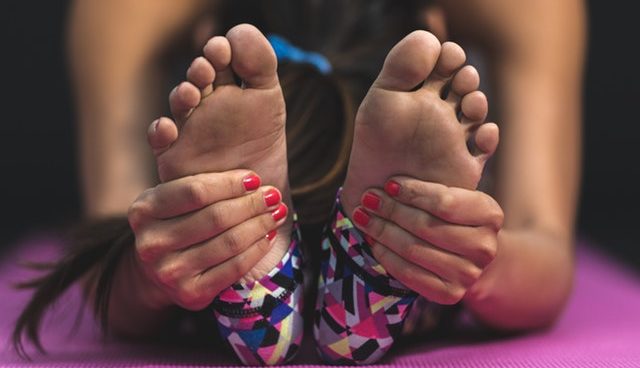
Hey everyone, Bill Hartman here. As the owner of IFAST Physical Therapy and co-owner of Indianapolis Fitness and Sports Training, I find solutions for people in pain that have failed from other forms of treatment.
From pros to average Joe's (and Jane's), I’ve worked with them all to regain a fit, pain free body and optimize performance and health.
My goal today is to give you a brief overview of how breathing influences movement, conditioning and recovery. The most important thing I want to share is a model of performance that expands from “local recovery” to one that looks at the body as a whole.
When it comes to performance (or movement) and recovery, most coaches and trainers tend to focus on the muscular system as the determining factor. It usually goes something like this:
1. Provide adequate stimulus to the muscles we want to get bigger, stronger, more conditioned and more powerful to enhance performance or body composition (or both).
2. Get adequate rest between workouts or competitions and supply the body with the nutrients it needs to repair the muscles involved so that they can be ready to do their job again when needed.
Get that at least mostly right, and things will turn out favorably for you or your clients and athletes.
Simple, right?
It would be nice if it were that easy. Problem is, humans are not machines. It’s not as simple as looking at the body as a collection of individual parts.
Looking at performance and recovery as purely local to the muscular system doesn’t tell us the full story. It’s an incomplete view.
Fact is, your body is connected by a number of subsystems, each playing a vital role in your performance, recovery, and overall health. Aiming to optimize movement and recovery of the muscular system is only one piece of the puzzle.
A better, more complete approach to performance, movement and recovery looks at things through an integrated model. One that takes each subsystem into account and integrates everything into one super system—or the “human system.”
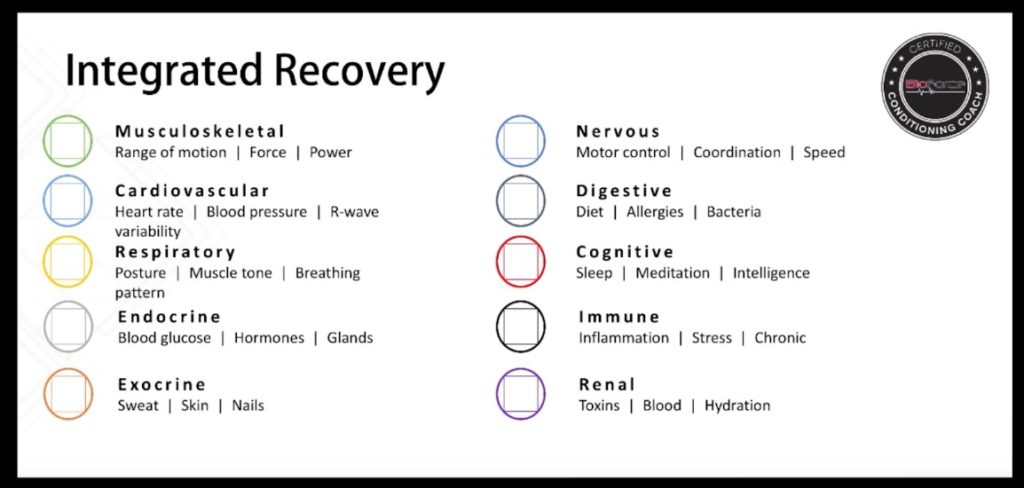
Each of these subsystems influences the others in our ability to manage and enhance both the outputs of performance and the recovery from it.
The first step toward optimizing movement and recovery is to move away from the outdated model where everything starts and stops with the muscular system, and begin adopting an integrated model that takes all of the different subsystems of the body into account.
In other words, we must STOP looking at the body as a bunch of individual parts and START looking at it as a collection of cohesive systems, all which are interconnected and working together.
Once you’ve made that shift, the next step is to understand that all of the different subsystems of the body are important, but one of them is what I’d consider the foundation everything else rests on.
A lot of bad things happen when you don’t breathe efficiently
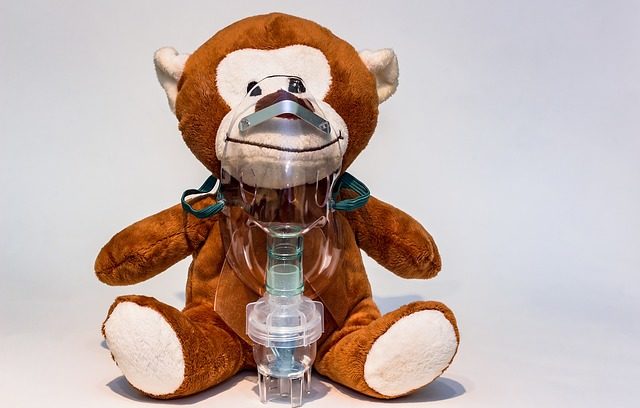
When it comes to optimizing fitness and performance, the two most crucial pieces of the health and performance puzzle, nothing is more important than proper breathing mechanics.
The act of respiration (taking a full breath in and out) is the most underutilized and overlooked aspect of movement and recovery because it is the foundation that allows all of the other subsystems to thrive.
Dr. Karel Lewit once said: “If breathing is not normalized—no other movement pattern can be.”
In other words: if you’re breathing poorly, everything else is going to be out of whack, at least to some extent. Proper breathing is that important.
Get your breathing right, and you have the raw materials to build upon so that every other system in your body can work together to facilitate optimal movement and recovery.
From a movement or performance standpoint, this should be obvious.
If you aren’t breathing correctly and efficiently, how can you expect to perform well in an activity where the most basic requirement oxygen?
It’s like expecting a race car to perform at top speed on the track even though it’s not getting enough fuel to the engine.
The mechanical effects of airflow, and how it can detract from or enhance movement cannot be overstated. With poor respiration patterns, posture and movement quality are always going to be compromised.
This is because breathing influences movement patterns, posture, pain, as well as performance. It does so by altering the position of the musculoskeletal system and causing restriction of airflow.
When this happens, it leads to under inflation or hyperinflation of your lungs, thus creating a mechanical barrier that limits movement. This barrier means your movement is going to become less and less efficient during training or competition.
Less efficient movement means that it takes more metabolic energy to do everything. The more energy you have to expend, the faster you’re going to fatigue and more your performance is going to decline.
In other words, in a very real way, being able to move optimally during performance and exercise comes back to the ability to breathe correctly.
Breathing isn’t just about performance. How breathing impacts your health too

Recovery and health are affected in a similarly detrimental way. To really understand optimal recovery, we have to look past the muscles to the nervous system.
Recovery of the nervous system is a powerful influencer of how much power you can generate. When the nervous system is fatigued, this ultimately limits your movement capacity and performance.
But, we can also have to look at the bigger picture of how the nervous system also affects all the “subsystems” that are connected to it.
If your nervous system is chronically fatigued, even the best program in the world isn’t going to produce the results you want. Your progress will always suffer because of the “trickle down” effect that will occur.
For instance, a strongly activated, rigid, less adapted nervous system has a broad spectrum of consequences that often promote similar reductions in the ability of other systems.
An example: if the autonomic system is overtaxed and remains sympathetic dominant, you’ll end up with an excessive amount of stress hormones circulating through your body. As long as these hormones are elevated, your recovery is going to suffer because things like proper digestion and absorption will be interrupted.
Another problem: being sympathetic dominant also reduces the immune system’s ability to manage inflammation. This can promote the inability of soft tissue to hypertrophy or adaptively reconstruct properly.
Over time, this is how end up with degeneration of tissues, such as tendons. All too often, this degeneration leads down the path of injury.
Remember: Everything is connected.
Put simply, the more sympathetic dominant your nervous system is:
1. The less efficient your body is at facilitating proper movement and technique (i.e. your performance during the workout session or competition is below what you’re capable of).
2. The slower your recovery from training or competition is going to be. This often means you’ll find yourself walking around in a low-level state of fatigue and your performance will be compromised the next time you show up for a workout or competition. When continued for long enough, this will negatively affect overall health as well.
One thing I want point out is that it’s not just training or competitions stress than can lead to an overtaxed nervous system. Things that contribute to an overtaxed nervous system include:
- Poor sleep habits
- Persistent health issues
- Lack of necessary nutrients due to poor dietary choices
- Being a very driven, busy, “never quit” type of person
- Physical training/conditioning (yes—at the core, exercise is a “stress” on the body)
- Poor breathing patterns
Probably sounds like a lot of the clients and athletes walking through your doors, right? (And maybe even you?)
Obviously, addressing each of these environmental and behavior aspects of stress is important, but we have to take things one step at a time and fix the most important first. If had to establish a hierarchy of where to start, developing better breathing patterns would be at the top.
This is because proper breathing can shift the nervous system from its energy-output, sympathetically dominant state toward a more restorative, recovery based parasympathetic state.
The bottom line is this: In order to move optimally during training or competition AND facilitate recovery so you can see consistent progress, your nervous systems has to be in check.
The good news?
You can train respiration just like you can a muscle or any other component of health and fitness. With practice, you can develop better breathing mechanics and help drive increased oxygen and blood flow throughout the body.
This is absolutely crucial to maintaining a healthy, balanced nervous system.
And remember, the nervous system is connected to everything. If you want to help people speed up their recovery, improve their conditioning and get the best results out of their hard work, one of the best places to start is to teach them how to breathe.
It sounds good...but how do you actually apply this? (3 simple breathing exercises to improve movement and recovery)
Hey everyone, Mike Robertson here.
I am the co-owner of IFAST with Bill, who just finished talking about how important breathing is for performance and recovery.
I got started in the health and fitness industry nearly 18 years ago. Since then, I’ve had the opportunity to work with professional athletes from every major sport, helping them take their performance and health to the next level.
But, enough with the formalities, let’s get back to the real reason you’re here: how to use breathing to improve movement and ramp up recovery.
Bill did a great job of covering the why proper breathing mechanics are so important for optimal movement and recovery.
The next step is to begin implementing some specific exercises into your programming to teach proper breathing mechanics. This may sound strange, but most people—including the clients and athletes you work with—breathe incorrectly (or at the very least, less than optimally).
The good news is, as Bill outlined above, respiration can be trained just like any other component in your health, fitness, and performance programs.
I’m going to give you some tools to get started with right now.
Bear breathing
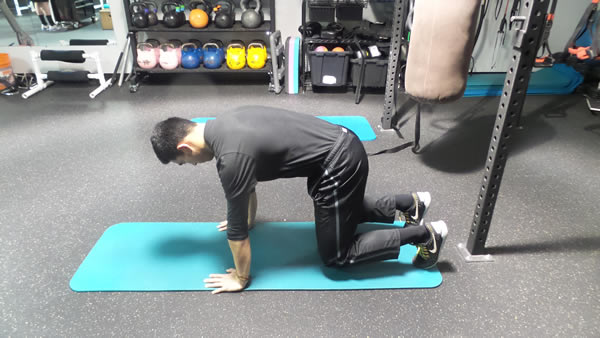
- Position yourself on all fours on the floor
- Hands should be directly below the shoulders and knees directly below the hips
- Push long through the arms as if to push away from the floor until you feel a stretch between the shoulder blades
- Bring the knees off the floor until the shin is horizontal to the floor
- Hold this position as you take 3-5 full breaths in through the nose and out through the mouth
- Relax and breath normally for a few seconds
- Repeat and perform 3-5 repetitions
Wall breathing
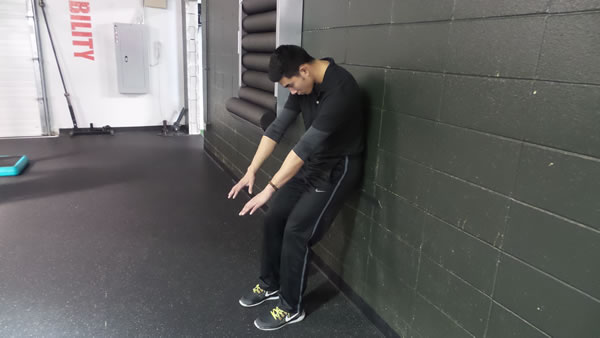
- Stand with your back against a wall and feet hip width and 10-12 inches from the wall
- Posteriorly tilt the pelvis to flatten the lower back against the wall
- Reach forward maximally with both hands allowing the upper back to round forward
- Hold this position for 3-5 breaths and then relax
- Repeat and perform 3-5 repetitions
Forearm plank breathing
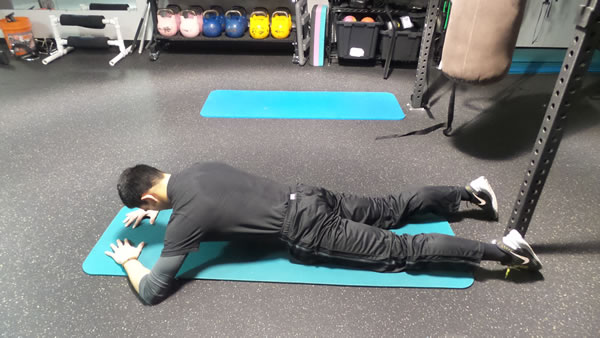
- Lay face down on the floor
- Place the hands below the face palm down on the floor such that they form a diamond shape with the index fingers and thumbs
- Push through the forearms and push the shoulders forward to lift the chest and abdomen upward off the floor until weight is only on the forearms and pubic bone
- Hold the upward position and perform 3-5 full breaths in through the nose and out through the mouth
- Return to the starting position
- Repeat and perform 3-5 repetitions
As I mentioned in the video, the great thing about these recovery breathing exercises is that they can be used just about any time.
They are incredibly easy to incorporate into a dynamic warm-up or cooldown and they can even be done outside of the gym at home. After just a couple of minutes of doing this type of breathing, you'll often feel noticeably looser and more relaxed because they help turn on the parasympathetic nervous system as Bill mentioned.
Try incorporating a couple of these exercises into your daily routine and you'll quickly feel the difference.
Learn the most effective strategies to help people breath more efficiently, move better, recovery faster and improve their conditioning
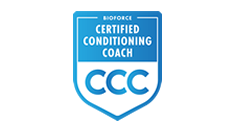 If you're a coach or trainer, the road from good to great is paved by continually acquiring new skills that you can add to your “toolbox.”
If you're a coach or trainer, the road from good to great is paved by continually acquiring new skills that you can add to your “toolbox.”
Learning to teach your clients and athletes how to breathe better is one of those things very few coaches out there are paying attention to. At some point, that’s going to limit their effectiveness—and the results of those they’re working with.
The great part is that with the right guidance, this is a skill you can develop to become a better, more complete coach. Learning how to coach these types of movements and improve breathing patterns over the last couple of years has made a big difference in the results I've seen personally and with the people that count on me to get them in shape.
That’s why I’ve brought Bill and Mike on board to contribute a brand new series of videos on movement, respiration and recovery to the BioForce Conditioning Certification. In this all-new section of the course, they cover all the information and practical know-how you need to optimize movement and recovery with the clients and athletes you work with.
As you learned today, breathing effectively not only impacts performance, it’s also crucial for recovery and a key element of conditioning. This is a skill set that I truly believe every coach must have because if they don't, the results they're able to produce will ultimately be limited.
Don't miss the chance to learn more from Bike and Bill and become a Certified Conditioning Coach the next time the course opens.